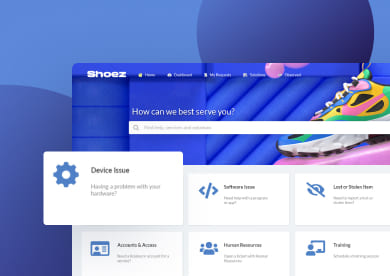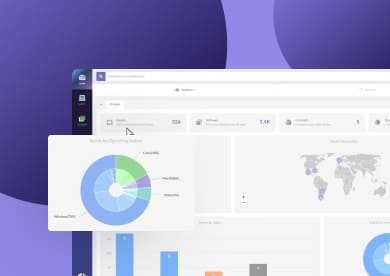Help Desk Software centralizes customer and employee support by converting requests from email, chat, and web forms into trackable tickets. Modern Help Desk Software solutions add automation and SLAs, a knowledge base for self-service, omnichannel communication, and reporting to improve service quality.
This article, written for help desk analysts, reviews 10 help desk software examples (a concise help desk software list) using publicly available information — features, integrations, pricing, and rating reviews — to help teams select a help desk ticketing system that fits their size, channels, and budget.
Methodology
InvGate develops IT Service Management and IT Asset Management software, so we’re directly involved in the same market as some of the vendors mentioned here.
Even so, our purpose is to share reliable and unbiased information to help you evaluate your options with confidence.
Our assessment is based on publicly available data, including vendor sites, documentation, analyst research, and user feedback from platforms like Gartner Peer Insights, G2, and Capterra. Whenever possible, we also test or review product demos. Each solution is examined for its functionality (ticketing, automation, KB, reporting, integrations), disclosed pricing, usability, and quality of support.
All information reflects the state of the market as of November 2025. We update our content regularly to keep it aligned with product changes and new releases.
The best 10 help desk software options in 2025
1. InvGate Service Management

InvGate Service Management is a help desk solution for all types of companies. Its easy-to-use interface and Low-Code/No-Code capabilities make it a flexible tool that can adapt to multiple industries — from IT and retail to education and healthcare.
Among its top features, it provides organizations with support ticket management, automation, workflows, and AI-powered capabilities. Plus, it holds a PinkVERIFY Certification for ITIL practices.
In addition, its dashboards and custom reports make it simple to monitor the tool's performance, and spot improvement opportunities on the fly.
And the best thing is that it can be implemented in just one day.
InvGate Service Management key features
- Self-service capabilities (self-service portal, knowledge base, service catalog).
- Workflow automation with a visual workflow editor.
- AI-powered features that offer agents suggestions on ticket recategorization and help agents write ticket replies.
- Native and third-party integrations.
- Multiple department integration.
- Gamification.
InvGate Service Management pricing
- Starter at $17/agent/month up to 5 agents.
- Pro at $40/agent/month from 6-50 agents.
- Enterprise offers custom pricing for larger organizations.
Want to see all these in action? Explore the pricing options and get a quote from InvGate tailored to your specific needs, or check how the tool works by signing up for a 30-day free trial.
InvGate Service Management user reviews and rating
InvGate is trusted by organizations like NASA, KPMG, PWC, and Allianz, and consistently receives positive feedback from users for its performance and reliability.
- Gartner Peer Reviews score: 4.8
- G2 score: 4.6
"We are definitely pushing all employees (4,500) to move from email to tickets. There is better control over them, determining times, necessary training and employee performance."
Martin Nuñez, Service Desk Manager at Harmony Public Schools
2- Freshservice® overview
Freshservice® is an ITSM solution from Freshworks designed for mid-size organizations. It features a clean interface with standard Incident, Problem, and Change Management capabilities delivered through cloud-based implementation. Freshworks also offers Freshdesk, their customer service-focused product, which differs from Freshservice in its emphasis on external customer support rather than internal IT processes.
Freshservice key features
These are some of Freshservice's features according to rhe company’s product page (accessed November 2025)
- AI-powered automation for ticketing (FreddyAI).
- Change and release management
- Customizable reporting and dashboards
- Unified Configuration Management Database (CMDB).
- Omnichannel support.
Freshservice pricing details
It offers 3 subscription levels. Prices for annual billing are:
- Starter: $19 per agent, per month.
- Growth: $49 per agent, per month.
- Pro: $99 per agent, per month.
The fourth tier, Enterprise, requires a quote. - Checked on Nov 2025 (US) official website.
Freshservice user reviews and ratings
- Gartner Peer Insights score: 4.2
- G2 score: 4.6
3- Jira Service Management® overview
Jira Service Management® is Atlassian's ITSM solution built on their popular Jira platform. It offers strong integration with development tools and excels in environments where IT and development teams work closely together. Available as cloud, on-premise, or data center deployment options, it's particularly effective for organizations already using Atlassian products.
Jira Service Management features
The following features are listed on the platform’s official features page (accessed November 2025).
- Customizable request forms and automation rules.
- SLA management with escalation paths.
- Deployment tracking connected to CI/CD tools.
- AI-powered virtual service agent.
- Root cause investigation for deployments and third-party services.
Jira Service Management pricing details
Offers tiered subscription plans based on the number of agents.
- Free: Free for up to three agents.
- Standard: $19 per agent, per month.
- Premium: $48 per agent, per month.
Starting with 201 agents, you can contact the sales team to access the quote for the Enterprise plan. - Checked on: Nov 2025 (US), official web.
Jira Service Management user reviews and ratings
- Gartner Peer Reviews score: 4.4
- G2 score: 4.3
4- Zendesk® overview
Zendesk® is primarily a customer relationship management (CRM) and customer service platform. It includes a help desk module that supports ticket management, workflow automation, and communication across channels such as email, chat, and social media. The platform offers a cloud-based setup and integrates with a wide range of business applications, making it suitable for organizations that need a centralized system to manage customer support.
Zendesk features
These are among the tool’s main features, as per their official web (accessed November 2025).
- Multi-channel support (email, chat, social media, and voice).
- AI agents: Automated assistants that help resolve conversations from any channel.
- Copilot: An AI-powered suggestion tool for agents and routing decisions.
- Messaging and live chat.
- Help center (self-service knowledge base).
Zendesk pricing details
The customer service plans focus on external client support across channels, while the employee service plans are designed for internal teams managing requests within the organization.
This pricing corresponds to annual billing:
- Customer service:
- Support Team: $19 per agent/month.
- Suite Team: $55 per agent/month.
- Suite Professional: $115 per agent/month.
- Suite Enterprise: $169 per agent/month.
- Employee service:
- Suite Team: $29 per agent/month.
- Suite Growth: – $59 per agent/month.
- Suite Professional: $98 per agent/month.
- Suite Enterprise: price available upon request.
- Checked on: Nov 2025 (US), official website.
Zendesk user reviews and ratings
- Gartner Peer Reviews score: 4.2
- G2 score: 4.3
5- Zoho Desk® Overview
Zoho Desk® is a cloud-based helpdesk and customer service solution. It offers ticket management, automation, multi-channel support (email, social, chat), and a knowledge base for self-service. The platform integrates with other tools in the Zoho ecosystem as well as many third-party apps.
Zoho Desk features
The company’s product page (accessed November 2025) highlights these as part of the platform’s offering.
- Omnichannel ticketing: Manage queries from email, chat, social, and more in one place.
- Built-in AI (Zia) for tasks like ticket tagging, sentiment analysis, and predictive insights.
- Guided conversation for self-service.
- Self-service and knowledge base.
- Built-in analytics and real-time insights.
Zoho Desk pricing details
These are the pricing tiers for Zoho Desk (billed annually)
- Express: $7 per agent per month.
- Standard: $12 per agent per month.
- Professional: $20 per agent per month.
- Enterprise: $35 per agent per month.
- Checked on: Nov 2025 (US), official website.
Zoho Desk user reviews and ratings
- Gartner Peer Reviews score: 4.5
- G2 score: 4.4
6- Salesforce Service Cloud® Overview
Salesforce Service Cloud is a cloud-based customer service platform that helps teams manage cases, support requests and customer interactions across channels. It offers features like omni-channel support (email, chat, phone, social media), workflow automation, and analytics to help support teams respond more efficiently. It ties into the broader CRM from Salesforce, so you can link customer service work with sales, data, and other customer-touch processes.
Salesforce Service Cloud features
According to official product information (accessed November 2025), the platform provides these key features.
- Unified agent workspace (“Service Console”) that gives support staff access to intelligent recommendations, automated case wrap-up, and insights.
- Omnichannel routing and case assignment that matches incoming work (email, chat, phone, etc.) to the right agent based on skill, availability or queue.
- Generative and predictive-AI assistance (for example auto-replies, article suggestions, conversational bots).
- Self-service portal and knowledge-base integration.
- Analytics, dashboards, and real-time insights.
Salesforce Service Cloud pricing details
- Starter Suite: $25 user/month
- Pro Suite: $100 user/month
- Enterprise: $175 user/month
- Unlimited: $350 user/month
- Checked on: Nov 2025 (US), official website.
Salesforce Service Cloud user reviews and ratings
- Gartner Peer Insights score: 4.4
- G2 score: 4.4
7- Help Scout® Overview
Help Scout® is a cloud-based help desk and customer communication tool designed around a shared inbox model. It enables teams to manage customer conversations from a single workspace, with tools for tracking messages, assigning ownership, and maintaining continuity across threads. In addition to email-based support, it includes live chat and a knowledge base to support self-service.
Help Scout features
These are some features of Help Scout taken from its official documentation (accessed November 2025):
- Shared inbox that consolidates customer conversations from email, live chat, social, and websites.
- Knowledge base (“Docs”) for self-service support, enabling the creation of documentation sites.
- AI-assisted tools, including auto-draft replies, summarizing long threads and self-service AI responses.
- "Beacon", an embeddable widget that can be added to a website or mobile app and brings together contact options.
- Reporting and analytics to track metrics.
Help Scout pricing details
These are Help Scout pricing plans (billed annually):
- Standard: $25 user/month
- Plus: $45 user/month
- Pro: $75 user/month
Plus, AI answers is an add-on that costs 0,75 per resolution. They offer a free plan that includes five users, one inbox, and one Docs site.
- Checked on: Nov 2025 (US), official website.
Help Scout user reviews and ratings
- Gartner Peer Insights score: 5.0 (one review)
- G2 score: 4.4
8- HappyFox® Overview
HappyFox® is a help desk and ticket management platform that centralizes customer and internal requests within one system. It supports communication across multiple channels, along with categorization and prioritization tools to organize work efficiently. It’s adaptable for both customer-facing and internal service operations, depending on the organization’s needs.
HappyFox features
These are some of the key features of HappyFox help-desk software, drawn from their official documentation (accessed November 2025).
- Ticket Management: Mass replies, custom statuses, filtering, merge/split tickets, bulk-updates.
- Smart rules and canned actions to automate assignments, status changes, notifications, and other workflows.
- SLA Management, monitor breaches and escalate accordingly.
- Custom fields for tickets and contacts, custom statuses and priorities, roles, and permissions per staff.
- Knowledge base / self-service: Articles, sections, search suggestions, multilingual support, and internal/external article visibility.
HappyFox pricing details
HappyFox offers two pricing models, depending on whether an organization prefers plans based on agents or ticket volume.
-
Agent-based plans (billed annually):
- Basic: $24 per agent/month (up to 5 agents).
- Team: $49 per agent/month.
- Pro: $99 per agent/month.
- Enterprise Pro: Quote-based.
-
Unlimited agent plans (annual pricing based on ticket volume):
- Growth: $1,999 per month. 20,000 tickets/year.
- Scale: $3,999 per month. 150,000 tickets/year.
- Scale Plus: $5,999 per month. 300,000 tickets/year.
- Ultimate: Quote-based. 1,000,000 tickets/year.
- Checked on: Nov 2025 (US), official website.
HappyFox user reviews and ratings
- Gartner Peer Insights score: 4.5 (2 reviews)
- G2 score: 4.5
9- HubSpot Service Hub® Overview
HubSpot Service Hub® is a customer support and ticketing system that operates as part of the HubSpot CRM platform. It offers a connected environment where service teams can track tickets, collect customer feedback, and manage requests alongside marketing and sales information. The tool is designed to centralize customer communication, helping organizations maintain visibility across all interactions and measure the quality of their support delivery through reporting and feedback tools.
HubSpot Service Hub features
On their official website (accessed November 2025), HubSpot lists these features for their Service Hub:
- Omnichannel communication: Provides support across email, chat, phone, social, and other channels in one system.
- SLA and routing controls: Tools to manage service-level agreements, intelligent ticket routing, and team assignment.
- Knowledge base and customer portal: A self-service resource for customers with a secure portal and searchable articles.
- Analytics with out-of-the-box reports and dashboards to measure team performance in real-time.
- Automated routing and workflows for conversations. Trigger notifications, set reminders, and generate tasks across teams.
HubSpot Service Hub pricing details
These are their official plans:
- Starter: $50/month. Includes 2 paid users.
- Professional: $500/month. Includes 5 paid users.
- Enterprise – Starts at $1,500/month. Includes 10 paid users.
Each tier allows you to purchase additional paid users for an added cost per seat. Only paid users have access to full Service Hub features, such as ticketing, workflows, and automation tools.
HubSpot’s AI tools use HubSpot Credits, which are consumption-based. Credits are shared across the platform and required to access AI-powered features like content generation, conversation summaries, and data enrichment.
For more details, contact their team.
- Checked on: Nov 2025 (US), official website.
HubSpot Service Hub user reviews and ratings
- Gartner Peer Insights score: 4.6
- G2 score: 4.4
10- HelpDesk® Overview
HelpDesk® (by Text) is a ticket management solution that brings together messages from various sources, such as email, chat, and web forms, into a single queue. It focuses on simplifying the organization of support requests, assigning responsibilities, and tracking progress through each stage of resolution.
HelpDesk® features
Based on their official documentation (accessed November 2025), the platform supports these functionalities.
- Automation and workflows: Pre-built rules, macros, canned responses, auto-assignment, and templates.
- Multichannel support consolidates messages from email, live chat, contact forms, web, and social and integrates with other apps via API/Marketplace.
- Collision detection (to avoid duplicate work), multiple team roles (agent, admin, viewer), and follower/mention functionality.
- Dashboard and exportable reports, custom domains/reply addresses, custom fields/filters, tags, ticket statuses.
- AI features: similar-ticket suggestions, tag recommendations, and one-click ticket summaries.
HelpDesk® pricing details
HelpDesk® offers three subscription levels:
- Team: $29 /user/month (billed annually).
- Business: $50 /user/month (billed annually).
- Enterprise: Quote-based
They also offer a 14-day free trial.
- Checked on: Nov 2025 (US), official website.
HelpDesk® user reviews and ratings
Disclaimer: All product names, logos, and brands are property of their respective owners. All company, product, and service names used on this site are for identification purposes only. Use of these names, trademarks, and brands does not imply endorsement. Comparisons are based on publicly available information as of October, 2025 and are provided for informational purposes only.
Help desk software types
- SaaS (cloud-based) help desk: Hosted by a third-party provider and delivered as a subscription service. The vendor manages infrastructure, updates, and security. This option is scalable and requires minimal IT maintenance, making it ideal for organizations that want a hassle-free solution.
- Web-based help desk: A browser-accessible help desk that doesn’t require installation on local machines. While often a type of SaaS, some web-based solutions can also be deployed on private servers, offering more control. These are useful for remote teams needing access from any device.
- On-premises help desk: Installed on an organization's own servers and managed in-house. This option is best for businesses with strict security, compliance, or customization requirements and the resources to handle maintenance.
- Hybrid help desk: This type of help desk combines cloud and on-premises elements, allowing organizations to store sensitive data in-house while using cloud-based features for flexibility and remote access. This is useful for businesses that need both security and scalability.
How to choose IT service desk software
Let’s review some essential criteria to evaluate Service Desk options and ensure efficiency, scalability, and alignment with business needs.
- Core ITSM capabilities and flexibility: Ensure the tool supports Incident, Request, Problem, and Change Management while allowing customization of workflows, SLAs, and automation to fit your processes.
- User experience and self-service: An intuitive interface, easy ticket submission, and a robust self-service portal with a knowledge base can improve adoption and reduce ticket volume.
- Automation, AI, and integrations: Look for AI-driven suggestions, automated workflows, and seamless integration with IT Asset Management, monitoring tools, and communication platforms like Slack or Microsoft Teams.
- Scalability and performance tracking: The software should accommodate growth, whether through increased users, multiple departments, or global support. Strong reporting and analytics help track performance, identify trends, and ensure SLA compliance.
- Security, compliance, and deployment options: Verify data protection measures, compliance with standards like GDPR or ISO 27001, and whether a cloud-based or on-premises model aligns with your IT strategy.
- Cost-effectiveness and vendor reliability: Assess total costs, including licensing, training, and ongoing support. A vendor with strong customer service, a responsive community, and long-term reliability is crucial for sustained value.















